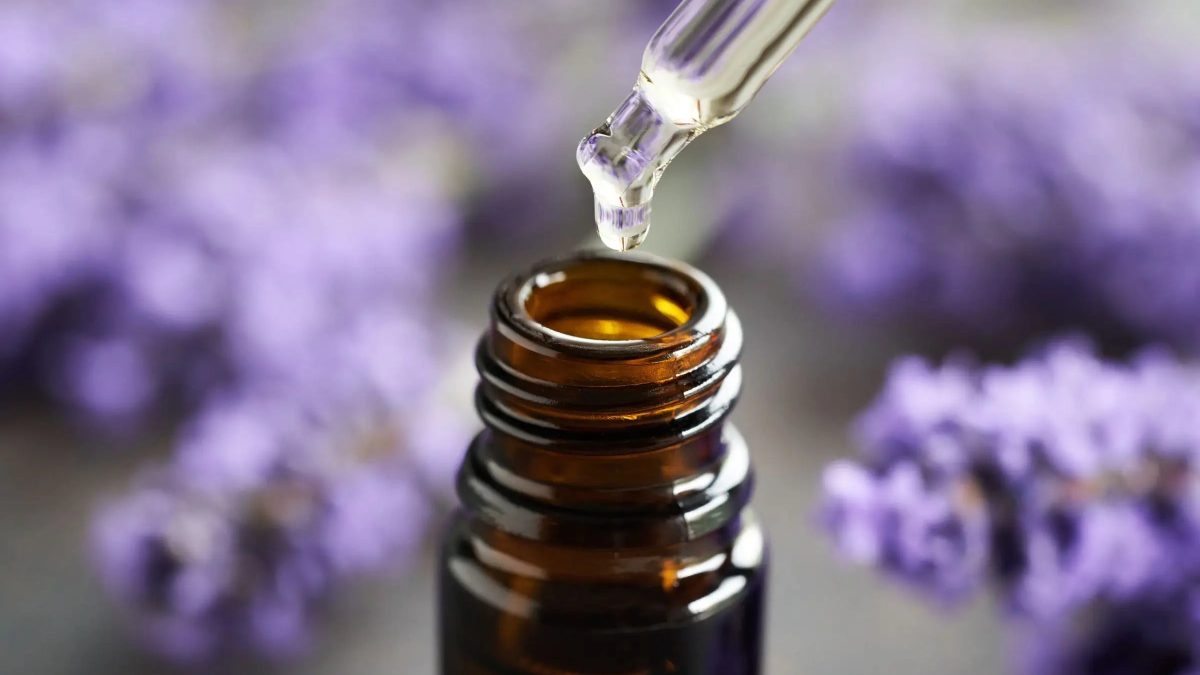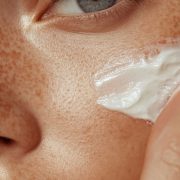Harness the Calming Power of Lavender for Serene, Radiant Skin
Posted on September 22, 2024 Written by: 100% PURE®

If we had to put an herb in a time capsule knowing that its lavishing benefits would be of great use to generations to come, it would be lavender. From its super skin-soothing benefits to its all-star anti-inflammatory properties, lavender is skin’s SOS for calming complexions and rescuing stressed skin.
Thankfully, we have the legendary, delicately fragrant bloom and its flower powers couldn’t have come at a better time! With growing concerns about harsh, irritating chemicals in the overwhelming world of synthetic skincare solutions, lavender oil has become a go-to choice for those who struggle with skin irritation and stress-related skin issues.
Follow along as we frolic through lavender’s fields of full blooms and benefits, exploring the benefits of lavender oil and how this essential oil has garnered a reputation as a natural, time-tested remedy. We’re sending out an SOS to rescue sensitive or irritated skin types with the super-calming flower power of lavender skincare!
Understanding Lavender Oil
Lavandula angustifolia a.k.a. English lavender has long been treasured in its oil form for its lavish scent and healing effects. This legendary botanical belongs to the mint family, but its taste and aroma are wholly unique. The subtle, crisp scent profile has been described as a mix of floral, herbal, and evergreen woodsy with a soft, smoky twist.
Lavender oil has always been a favorite among essential oil lovers. But how exactly do those flowers transform into their well-used and respected oil form?
Lavender is usually hand-harvested from the fields. The flowers are tied together in bunches and laid out to dry for several weeks. This is to prevent the oil from going rancid, and the buds are more easily removed from the stems when they are dry.
Once the flowers are sufficiently dried, it’s time to begin steam distillation. Steam distillation ensures you get the most benefits from lavender, without being contaminated by acetone or hexane used in solvent extraction methods.
During distillation, lavender buds are placed above boiling water, and as the boiling water gently steams the lavender, the high pressure and heat push oil out of the flowers. The steam carries the mixture of steam and oil to a condenser – this is where it’s cooled and turns back into a liquid. The steam becomes a hydrosol, and precious drops of lavender oil are naturally separated.
Lavender’s long history as a beauty and medical treatment suggests that lavender oil is far more than just a pretty plant. The word lavender is understood to derive from the Latin root lavare (to wash because lavender infusions have been used for centuries for hygiene and personal care. In fact, both the Greeks and the Romans used lavender to scent their clothes, beds, and baths, so we’re drawing on a seriously long tradition when we incorporate lavender into our skincare and bath formulas.
The Romans also considered lavender to be a holy herb, which they used to create a tonic referred to as “holy essence” in the Old Testament. In both Greek and Roman traditions, lavender was understood to be a powerful curative herb that was typically included in elixirs of life. There was even a lavender-based potion known as mithridatum that dates to the second century BC, which was used as an antidote for poison for centuries. All of these were more than just early medicinal folklore or haunted woods hocus pocus, given the highly antiseptic nature of lavender oil.
Queen Victoria was also a huge enthusiast of lavender. She made sure that all her furniture, linens, and floors were cleaned with a lavender-based solution, and her drink of choice was lavender-infused tea for its digestion-enhancing properties to help ease her stomach. Lavender was highly fashionable during the Victorian era, with many women using it in various forms like sachets and perfumes.
Lovely looks and loaded benefits aside, the science behind lavender’s skin benefits is attributed to its key components and their properties for the skin. Lavender oil’s main components, linalool, linalyl acetate, and camphor, have many properties that can benefit the skin.
Anti-inflammatory: These compounds can help relieve skin conditions like eczema, dermatitis, psoriasis, itching, and rashes.
Antioxidants: Linalool and linalyl acetate protect the skin and help tackle free radicals that can damage skin and accelerate skin aging. They also prevent and heal acne breakouts.
Cleansing and purifying: Lavender oil can help get rid of bacteria and other things that can clog or irritate the skin.
Pain relief: Lavender oil, especially the camphor in it, can help soothe painful inflammation and has numbing effects. Camphor has antibacterial, antifungal, and anti-inflammatory properties.
Calming: Lavender oil can soothe, calm, and balance irritated skin.
These compounds work synergistically, giving lavender oil potent cleansing and purifying properties. With these active compounds, lavender oil becomes a jack or flower-of-all-trades, even with its added properties to interact with skin cells and promote skin healing and calming benefits.
#1. Lavender oil neutralizes free radicals or the atoms that damage cells, which helps fight oxidative stress and UV damage that often leads to aging concerns and pigmentation issues.
#2. Essential oils from lavender reduce the expression of pro-inflammatory substances in the skin. The main active ingredients thought to be responsible for these effects were linalool and linalyl acetate.
#3. Lavender oil speeds up the process of wound healing. It may increase the production of collagen, a protein important for skin and healing.
#4. Lavender oil’s antioxidant content works to kill bacteria, and this can prevent and heal acne breakouts. Its antibacterial camphor helps fight bacteria, resulting in fewer skin irritations, breakouts, or acne.
Stress and Skin: The Lavender Connection
Managing stress is something we all tend to put off until it’s too late. High stress causes a chemical avalanche in your body that can move quickly down your skin. And it’s not just the high mental tension that affects skin health. It’s also environmental stressors that can create a ‘skin’ slide. You’re left with stressed-out skin.
Let’s pivot to learn about the stress and skin connection, and how internal and external stressors affect skin health – that is, until, we give it nature’s chill pill, lavender!
How stress affects the skin
When we become stressed, our heart rate goes up, our cheeks may redden – and of course, more importantly, we’re often left with a skincare catastrophe. Revved cortisol levels cause our skin to overproduce oil, often causing acne and imbalanced skin. On the flip side, stress can make skin drier and itchier by interfering with the skin’s ability to retain moisture.
Inflammation and oxidative stress:
When you’re stressed, your body releases chemicals like cortisol, which can cause inflammation and make your skin more sensitive. As we stress, less blood flows to the thin under-eye area as well, and inflammation arrives on the site that can cause changes in blood pigmentation. You look in the mirror and suddenly you have unsightly dark circles!
Oxidative stress and its resulting oxidative damages can exacerbate skin pigmentation, cause cell death, and speed up the aging process, inducing changes in the texture and tone of skin, pre-mature aging, and the breakdown of collagen and elastin, two proteins essential for maintaining the skin’s elasticity and firmness.
Disruption of skin barrier function:
Stress can disrupt the skin barrier function, which protects our stratum corneum and keeps moisture in and harmful elements and microbes out, ensuring your skin stays hydrated and resilient. When skin issues like dryness, irritation, redness, and sensitivity arise, it’s usually because this barrier has been compromised. Impairment of the skin barrier can also delay wound healing.
Common stress-related skin issues
Stress can cause skin to feel sensitive and flare up with spots and red patches. Stress can trigger or worsen skin conditions like eczema, psoriasis, acne, and urticarial.
Acne flare-ups and sensitivity:
Exposure to environmental stressors and pollutants can damage the skin and its barrier function, Environmental assailants can also alter the composition of its microbiome, leading to issues like increased sensitivity, acne, eczema, and other skin conditions.
Premature aging and dullness:
Stress hormones like cortisol break down collagen and elastin in the skin, which can affect the skin’s ability to ‘bounce back’ and retain its shape and firmness without sagging. Stress can make skin drier and itchier or duller by interfering with the skin’s ability to retain moisture. Stress hormones also interfere with rejuvenation, which can speed up the aging process causing more fine lines and wrinkles.

Lavender Oil’s Skin-Soothing Properties
With the overwhelming world of synthetic skincare being shoved aside for natural remedies, lavender skincare is defining the heart of beauty. This coveted oil not only boosts potent anti-aging properties but is also ultra-nourishing for the skin and comes with a heavenly therapeutic scent.
Anti-inflammatory effects:
Calming redness and irritation: Just as the inhalation of lavender oil can promote mental calm, this superstar oil offers the same calming benefits for your skin. Its soothing powers are derived from natural stores of beta-caryophyllene, which helps to reduce inflammation and pain. This makes lavender oil great for calming redness and irritated skin from cystic acne, insect bites, and sunburns.
Soothing eczema and psoriasis symptoms: Since lavender oil reduces inflammation and has antifungal properties, it helps to soothe dry skin and calm the red, itchy symptoms of eczema and psoriasis. Whether you’ve been scratching away from eczema or have dry skin, lavender oil for skin does an excellent job at balancing your skin’s moisture level and lessening persistent itching, which can damage skin or lead to infections.
Antioxidant protection:
Combating free radical damage: Free radical damage is caused by environmental stressors like UV rays and pollution, which can wreak havoc on our skin in the form of wrinkles and fine lines. Lavender oil is chock-full of beneficial antioxidants that can help fight and repair premature aging from these damaging radicals. The antioxidant properties of lavender oil also contribute to firmer-looking, more resilient skin.
Supporting skin’s natural repair processes: Lavender oil may help reduce the appearance of scars by promoting cell growth. Using lavender essential oil can also promote wound healing. It increases the production of collagen, which keeps your skin elastic and firm and helps with cell turnover.
Antimicrobial action:
Addressing acne-causing bacteria: Acne often rears its ugly head when you don’t have enough oil! That’s because parched skin will try to overcompensate for your skin’s natural oil or sebum, and that’s a recipe for clogged pores and blemishes. Lavender oil has naturally antibacterial and antifungal properties, which help kill harmful acne-causing bacteria and fungus to prevent and heal acne breakouts.
Promoting a healthy skin microbiome: A healthy skin microbiome is characterized by diversity and balance of microorganisms, which is pivotal for skin health. Lavender oil helps maintain this balance, and, thus, the skin is better equipped to ward off infections and harmful pathogens, dryness, irritation, and painful or inflamed skin conditions.
Balancing sebum production:
Regulating oily skin: If your skin shines brighter than a diamond or you’ve been itching away at dry skin with no hope in sight, turn to lavender oil for some much-needed relief. Lavender oil does a stellar job at balancing your skin’s sebum or oil production and its moisture barrier so that your delicate dermis isn’t too oily or too dry.
Preventing clogged pores: Lavender oil helps prevent clogged pores by killing bacteria that can cause acne and unclogging pores. Lavender oil is non-comedogenic, meaning it won’t clog pores.
Incorporating er Oil into Your Skincare Routine
Lavender oil is one of the most popular oils in the world for a variety of reasons! It’s starting to catch on as a health staple, reaching far beyond spa or tub time. We’re covering proper application methods, the top reasons why you should be using at home, along with some fun DIY recipes to share with friends.
Proper dilution and application methods
Carrier oils and their benefits: When using lavender oil in , it needs to be diluted in a carrier oil; we love coconut, jojoba, or rosehip oil for their skin-calming and restoring properties. You can apply lavender oil directly to your skin with your hands for dry skin or wrinkles, or with a cotton ball for damaged skin. You can also mix lavender oil with a carrier oil to create a lotion.
For a bath, add 2–3 teaspoons of lavender oil to your bath water to moisturize your skin and help you relax. For a facial steam, add 5–6 drops of lavender oil to a facial steamer for a deep-cleansing routine. As a facial masque, add 3–5 drops of lavender oil to a moistened clay, honey, mashed avocado, or egg white and apply to your skin.
Ideal concentrations for different skin types: For adults, a 2–3% dilution is usually recommended, which is about 12–18 drops of essential oil per ounce of carrier oil. For people with sensitive skin, a lower dilution of 1% or less is recommended, which is about 6 drops per ounce.
DIY lavender-infused skincare recipes
Calming Face Mist:
To help aid your own sleep, simply make up a batch of this simple mist with the skin-efits of lavender oil and spritz it on your face and body. You can even give your pillow a light spray. This mist is perfect for spritzing over the face and body as a cooling tonic with the calming and soothing properties of lavender.
Calming Face Mist Supplies:
125 ml bottled or filtered water (to avoid the smell of chlorine)
Lavender essential oil
Step One:
Fill an empty spray bottle with pure, clean water and add 8-10 drops of lavender oil.
Step Two:
Shake well.
Step Three:
Close your eyes and spritz over your face and neck to refresh and calm your skin.
Lavender Oil Pillow Spray:
Are you having trouble sleeping or just looking to create a calming atmosphere before bedtime? You’ll want to whip up our DIY lavender oil pillow spray to keep on your nightstand to do just that. Spritz our lavender oil spray on your pillow, or sleep mask, or just a few pumps into the air above your bed right before you tuck yourself in. The soothing scent of lavender will have you slipping deep into dreamland in no time. Follow below for our super easy lavender oil-based DIY recipe!
Lavender Oil Pillow Spray Supplies:
1 Small Glass Jar with a tight-fitting lid (a mason jar would be best!)
10 drops of Organic Lavender Essential Oil
2 Tablespoons Organic Witch Hazel or Organic Vodka
6 Tablespoons Distilled Water
Small Funnel
Glass Spray Bottle
Step One:
Using a tight-fitting lidded jar, combine the organic witch hazel (or organic vodka) with the organic lavender oil. Tightly screw on the jar’s lid and shake vigorously for 15 to 20 seconds to help combine the two ingredients.
Step Two:
Carefully open the lid, then add the distilled water. Tightly screw the jar’s lid back on then shake vigorously for another 15 to 20 seconds to help combine the new ingredients.
Step Three:
Open the spray top to our final bottle and place the funnel on top. You’ll want to use a tiny funnel to make pouring easier! Pour the lavender oil mixture into the spray bottle, being careful not to overfill.
Step Four:
Print a cute label or use a permanent black marker to label your new lavender oil spray bottle.
Step Five:
Spritz away! Enjoy your new lavender oil pillow spray tonight – you’re just a few pumps away from pure tranquility.
Combining lavender with other skincare ingredients
Lavender oil can be combined with many other skincare ingredients to balance skin or intensify its skin-soothing and calming effects.
Carrier oils:
Lavender oil can be diluted with a carrier oil, such as coconut, jojoba, or grapeseed oil. Carrier oils can help protect the skin from potent essential oils, which may be too intense for sensitive skin types.
Other essential oils:
Lavender oil can be combined with other essential oils, such as frankincense oil, skin-moisturizing vitamin E, and rosehip seed oils, as well as with vitamin E and rosehip seed oil to create anti-aging, hydrating products. Add aloe vera with lavender oil to create a sunburn spray. Lavender oil can also be combined with moringa oil to treat and soothe irritated skin.

100% PURE Lavender-Infused Products
One of the best ways to reap the amazing benefits of lavender oil is by incorporating it into your daily skincare routine. Here’s how you can harness the calming power of lavender skincare for serene, radiant skin!
Lavender Tonique
Never miss a chance to refresh your skin on the go with a spritz of our . Made for all skin types, this balancing toner features a blend of gentle botanicals that work to purify, hydrate, and soften skin, this spray toner cleans and detoxifies pores while moisturizing your complexion. Calming lavender reduces acne scars and inflamed skin and soothes stressed skin.
Lavender Oat Milk Soothing Cleanser
Adding skin-enriching botanicals to your skincare regimen can halt sensitive skin in its tracks! Give skin an ultra-dose of skin-soothing benefits with our . Made with beta glucan-rich colloidal oatmeal, nourishing coconut milk, and anti-inflammatory botanicals, this skin-softening, calming cleanser gently washes away makeup and impurities. Purifying lavender fights acne and reduces scars.
French Lavender Hand Buttercream
Our ultra-rich, non-greasy French Lavender Hand Buttercream is formulated to deeply moisturize and nourish hard-working hands. Made in a base of decadent cocoa, avocado, and shea butters and instilled with anti-aging vitamins and super fruits to promote more supple, youthful-looking skin. Infused with aromatherapy benefits from the clean and calming scent of French lavender to soothe inflamed and irritated skin.
Lavender Body Scrub
Help kick dry, irritated, or itchy skin concerns to the curb with our French Lavender Body Scrub. Harness the power of French sea salt to slough away dead skin cells (while also aiding in the turnover of new ones) with the anti-inflammatory properties of lavender paired with potent anti-aging pomegranate and acai oil. The gentle exfoliating scrub will help you get a soothing, full-body treatment.
Lavender Sea Therapy Bath
Our Lavender Sea Therapy Bath combines lavender extract with ultra-detoxifying organic crystallized kelp to make a spa-worthy, ultra-cleansing, and calming self-care experience at home. It’s infused with therapeutic French lavender to soothe and calm skin.
The benefits of lavender oil for skin are seemingly endless – making it one of the easiest ingredients to add to your routine. For a deeper dive into the magic of this lovely bloom, check out our feature on the benefits of lavender for mind, body, and beauty. This flower isn’t the only plant hero with serious beauty benefits – check out our full list of the best essential oils for your skin!
Conclusion:
There’s a myriad of essential oils out there, but there’s one thing for certain that’s going to be hanging around in tie capsules for generations to come: lavender oil! While the benefits of this coveted oil are seemingly endless, it makes for one of the easiest ingredients to add to your skincare routine, especially if you’re looking for skin-calming effects of products.
The benefits of lavender oil for skin are seemingly endless – making it one of the easiest ingredients to add to your routine. For a deeper dive into the magic of this lovely bloom, check out our feature on the benefits of lavender for mind, body, and beauty. This flower isn’t the only plant hero with serious beauty benefits – check out our full list of the best essential oils for your skin!
Frequently Asked Questions:
Why is lavender oil one of the best ingredients for calming sensitive skin?
Lavender oil is known for its moisturizing and protective properties; its reduction in inflammation and promoting skin healing. These natural ingredients are gentle and effective in alleviating irritation, redness, and dryness, making it ideal for sensitive skincare routines.
How often should I use soothing products on my sensitive skin?
For optimal results, soothing products should be used consistently as part of your daily routine. Cleanse your skin twice daily—morning and night—followed by applying a hydrating toner, serum, and moisturizer. Masks or additional soothing treatments can be used 2-3 times a week, depending on your skin’s needs. Regular use ensures that your skin remains calm, hydrated, and protected from irritation, maintaining its overall health and comfort.
Can sensitive skin benefit from exfoliation?
Yes, sensitive skin can benefit from exfoliation, but it must be done gently. Opt for mild, non-abrasive exfoliants like those containing enzymes or lactic acid rather than physical scrubs. Exfoliate once a week to remove dead skin cells without compromising the skin’s delicate barrier. Over-exfoliating can lead to irritation, so it’s crucial to listen to your skin’s needs and adjust the frequency based on its tolerance.
What are the common triggers for sensitive skin?
Common triggers for sensitive skin include harsh chemicals in skincare products, extreme temperatures, environmental allergens like pollen and dust, and certain fabrics or laundry detergents. Stress, dietary factors, and exposure to UV rays can also exacerbate sensitivity. Identifying and avoiding these triggers can help manage and reduce symptoms of sensitive skin, leading to a more comfortable and balanced complexion.
How can I protect my sensitive skin from environmental damage?
Protect your sensitive skin from environmental damage by using products with antioxidants and SPF. Incorporate a broad-spectrum sunscreen with at least SPF 30 into your daily routine to shield against UV rays. Additionally, choose skincare products that contain soothing and protective ingredients like aloe vera and chamomile. Maintain hydration with a good moisturizer and limit exposure to extreme weather conditions to keep your skin resilient and healthy.




